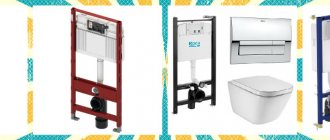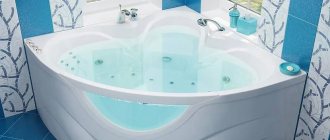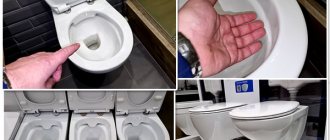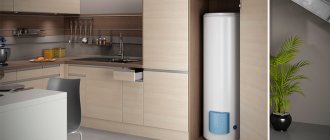It is very easy to live in a system where choices are limited, or where someone else decides for the individual. And how complicated everything becomes when the number of choices tends to infinity. It seems that quite recently, when repairing a toilet, residents of the CIS countries did not have any problems when purchasing a toilet. None. The plumbing products were identical, like twin brothers: they had the same shape, color and design. The only difference between them was their quality: some served for decades, others required replacement after a few years. That's why there were huge queues for Finnish plumbing fixtures.
Today, hundreds of toilets are displayed on the display shelves of large retail chains, and not one of them is like the other. They differ in color, material from which they are made, shape, and design.
Plumbing fixtures can come in the most unexpected shapes.
The choice of color and shape is made based on the taste of the owners, the style of the apartment in general and the toilet in particular. By design, many buyers are encountering a new product for the first time, which experts call installation. To understand how this system works and is installed, to understand what the installation’s pros and cons are, buyers are forced to look for answers on various forums.
However, the development of IT technologies, along with its benefits, often brings harm. First of all, this applies to forums. Competing companies do not always compete fairly and launch bots that write negative reviews about new products. Therefore, the editors of the site decided, with the help of specialists, to understand the design of a new type of toilet, its strengths and weaknesses. The explanations and assessments received formed the basis for recommendations on what to choose - an installation or a regular toilet.
What is a toilet installation
From some luxury in plumbing, designers returned to asceticism and simplicity. An installation is a special supporting structure that supports the weight of the toilet, flush cistern and related fittings. Due to the fact that a gap is formed between the plumbing fixture and the floor of the room, it seems to “hang” in the air, giving the impression of a light, elegant structure. And all the wiring and the tank are hidden, not conspicuous behind the false panel.
Like any innovation, the wall-hung toilet immediately divided users into ardent fans and opponents. Standard models also have every right to exist, because they:
- securely fixed to the floor
- fully fulfill their main function - satisfying natural human needs
A toilet with installation will definitely require the construction of a special partition - otherwise all pipes and connections will be visible. But this solution looks much more attractive than the traditional one. The secret lies in visual perception: in conventional plumbing fixtures, the tank looks like a natural extension of the bowl, increasing it in size (which is actually not the case). The hanging option leaves only the device itself visible. In addition, it is easier to fit into any interior - that’s what a toilet installation is.
The button for draining water is often made combined: for completely emptying the flush tank and for an economical one, only half emptying. A large control panel embedded in the partition will be an excellent solution for a separate or combined bathroom. And the water supply and sewer riser are located on the other side - no need to worry about special boxes or casings to hide them from prying eyes.
Another important advantage is that the floor pattern can be made mosaic, uniform over the entire area. And cleaning adjacent areas is now much easier. As an additional advantage, they cite the fact that such fastening of the bowl does not interfere with the installation of heated floors throughout the room.
Standard sizes
The usual dimensions of the toilet installation allow it to be installed in any room of any size. Corner options are installed in the corners of small bathrooms (often combined). Compact models of reduced height are also produced for placement under windows. Linear modules are used for suspended equipment placed in a line. The parameters of unusual options do not correspond to the standard ones.
Width
Block and frame devices have the same parameters, therefore the width of the installation for the toilet is independent of the type of structure. It is about 55 cm. This is enough to place the flush tank inside the frame. Most modules are half a meter long and are perfect for plumbing fixtures of various sizes.
The size of the installation determines the volume of the tank. The latter should be large enough, then the bowl will always remain clean.
The width of the toilet installation does not depend on its type: frame and block standard systems have the same parameters of 500-600 mm Source samstroy.com
Depth
An important parameter that depends on the type of frame. The thickness of frame installations is 15-30 cm, block installations are approximately half as thick. The latter allow you to save about 15 cm of space.
The depth of the structure affects the size of the drain tank located inside the frame. Hanging plumbing has a flat tank, its dimensions are approximately 50x60x9 cm.
Installation dimensions
One of the most important parameters: it determines what exactly you need to buy to securely fasten the bowl and fittings, as well as the compatibility of the purchased installation with existing technical conditions. For example, a narrow and tall installation will not be suitable for a wide bowl, and a block design cannot be used in a room with non-load-bearing walls.
Don’t forget about the design: some people like ascetic, extremely functional products with a minimum of additions, strict in form, neutral white. But some are more attracted to toilets with the maximum level of comfort, completely transparent or in the Art Deco style.
In any case, before choosing an installation, you need to know the height of the toilet, focusing on the anatomical indicators of those who will use it. This requirement should become basic. Another parameter fits in with it: what is the maximum weight the toilet installation can withstand. On average, it is believed that the supporting frame is designed to support a weight of up to 500 kg, but this figure varies depending on the specific case.
What exactly the installation for the toilet should be - low or higher - can be determined experimentally: measure the height of the chair, focusing on the tallest and smallest member of the family. Usually it is from 40 to 50 cm (it makes no sense to do it higher). An important clarification: when sitting on a toilet with a standard-width installation, your legs should not dangle in the air. You need to focus on adults, as children grow.
How much specific space is needed to install the device is determined by the design of the plumbing fixtures. There are corner solutions that are quite compact and functional. Another serious point when figuring out the question of how much free space is needed for a toilet with installation is the layout of communications.
In the existing dimensions of the bathroom, you will have to be tied to the connection points of the water supply and sewerage (so that you do not have to completely redo the entire pipeline). Another thing is a new house or the possibility of free redevelopment: in this case, you don’t have to worry about how much space the installation takes up along with the toilet, what kind of design it will be, but focus solely on comfort and design.
Installation - Mounting System
Based on the type of installation, they are divided into 2 large groups:
- Block
- Frame
The first option involves mounting it in a niche to a load-bearing wall. The second is designed for fastening to the floor (in conditions of weak walls or partitions in the room) or to supporting structures. It is problematic to unequivocally recommend one or another option: they will equally cope with the task. The difference between them is in the type of fastening; you need to pay attention to it (depending on your specific situation, type of room and wall design).
In terms of reliability, both options are equivalent: they carry a weight of up to 500 kg, and allow you to hide all communications behind a false panel made of plasterboard or plastic.
In addition to those mentioned, there are compact frame solutions with which the toilet can be easily installed under a window or in a corner - this is also sometimes necessary.
A wall-mounted toilet can be equally mounted using a block or frame method: it all depends on the installation location and the conditions for placing the bowl. A block installation, as a prerequisite, requires fastening to a load-bearing (main) wall; the frame can be supported and fixed to the floor.
What does the installation consist of?
The structure, which takes on the weight of the suspended bowl along with the person sitting on it, and also serves to communicate the supplied water fittings, must be strong, rigid and firmly attached to the wall or floor. In essence, the installation consists of steel elements of a certain cross-section, forming an almost monolithic spatial solution.
Almost all modern plumbing fixtures for the toilet are equipped with a double flush function: this helps to use water efficiently.
And the installation for an attached toilet is a kind of adapter in which a tank with a flush system, a sewer outlet and fittings for water supply are mounted. The solution is completely ready for installation, so no additional configuration or selection is required. That is why the type of fastening is clearly tied to a specific type of toilet. And it is important to take into account all the necessary nuances in advance in order to avoid possible mistakes.
Monoblock
The production of monoblocks has become a real alternative to installation due to a number of advantages that compact toilets do not have:
- simple equipment - solid cast toilet;
- ergonomic shape of the bowl - it is comfortable for any family member to sit, even with disabilities;
- smaller linear dimensions, which is why it requires less space than a classic “compact” toilet;
- easy maintenance – the absence of a “dead zone” makes cleaning the bathroom easier;
- easy installation;
- the presence of a microlift - the lid lowers smoothly and silently;
- some models are available as a shower toilet (this feature also appeared on compact toilets);
- no leaks at the drain tank;
- efficiency - most models use several drain modes.
The disadvantages include:
- higher price compared to compact models;
- the inability to repair the tank drain system (theoretically, it is possible to replace a failed element, but in practice it is extremely difficult) - only a complete replacement of the fittings, which is quite expensive.
Types of wall-mounted toilets
The consumer is offered a fairly diverse range of models from leading manufacturers Grohe, Jika, Kludi, Geberit, Cersanit and others. They differ in shape, material, method of fastening, as well as price.
Fans of non-standard solutions will like the square wall-hung toilet: strict shapes, unique design.
The choice in favor of a toilet combined with an internal shelf is justified if you do not want to install special systems to reduce the level of splashes - anti-splash. In part, this solution helps to avoid objects (for example, a telephone or toilet paper) from falling into the drain hole: they remain on the shelf.
A wall-hung toilet combined with a hygienic shower will be appreciated by ladies: according to reviews, such a device is much more comfortable than a bidet.
A round wall-hung toilet with a special flushing solution does not create a continuous flow of water (as in conventional solutions), but moves in a spiral, which, in turn, increases efficiency and leaves less dirt on the walls.
Flush button
In a suspended system, the flush button, for obvious reasons, is mounted separately from the cistern, on a false wall that hides the installation. The consumer sees only a decorative panel with one or two keys. By design, the button can be:
- ordinary
, with a single key, when pressed, all the water in the tank is drained; - economical with a bipartite key
: by pressing one half, you drain all the water from the tank, when you press the other, only half of the water; - economical with the “start-stop” function
: the first press opens the drain, the second closes it, i.e. you regulate the amount of water drained yourself.
The key is connected to the drainage system using a pneumatic drive, a special lever or a cable.
GROHE Sail flush plate, chrome
Difficulties in working with installation
Most of the problems that are usually associated with a wall-hung toilet, as well as the complexity of its installation, can be reduced to a reasonable minimum if you carefully follow the recommendations of the manufacturer and plumbers.
Firstly, before you begin any work on installing plumbing, you must have a clear idea (plan) of the installation location, the sequence of actions, the specific model, and the type of installation. It is better to waste time working through all possible options for renovation in the bathroom, including replacing the toilet, than to later try to correct mistakes made at the design stage.
Secondly, it is important not only to install the installation, but also to ensure that it works correctly and efficiently.
Perhaps it is precisely because of some of the complexity of installation that professional plumbers often recommend a reliable, justified classic: a toilet attached to the floor, rather than suspended. But wall-hung toilets have their own advantages in terms of characteristics. For example, they create much less noise. And outwardly they look more aesthetically pleasing and airy.
Recently, compromise solutions have appeared that make it possible to use a wall-hung toilet without installation: it is believed that they are no worse than others. There are also quite a lot of people who will vote in favor of a frame or block for attaching the bowl.
Price
One of the main issues is the renovation budget . And here everything is quite clear: a wall-hung toilet will obviously cost more than a floor-standing one. The price of a wall-hung toilet bowl is approximately the same as that of a similar floor-standing model, or a little more expensive. But you will also have to buy an installation system.
You can choose a kit that includes everything you need, it will cost about 20-30 thousand rubles. But if special design requirements arise, the price rises. For example, it is often necessary to select an installation of a non-standard size in order to save space.
The cost can also increase due to flush buttons. The installation kit includes a standard version. But in design projects they are often replaced with more aesthetically pleasing ones that fit the overall interior of the room. These buttons can be of different colors and made of different materials: glass, plastic, metal.
NB! The buttons also differ in their pressing system. The standard option is mechanical. Behind the button is a lever that presses the valve. Another option is pneumatic, with an air tube. They are chosen if the button is located not as usual, behind the back, but on the side.
Another cost item is installation. Installing a floor-standing toilet is quite easy; you can do it yourself or invite any plumber. But with the suspended version the situation is much more complicated. It is necessary to correctly install the installation at the stage of rough repairs, then sew the installation into a box, and finally install the bowl and flush buttons.
These jobs are much more complex and it is important to do them correctly. Manufacturers claim that most breakdowns are not due to shortcomings of the models, but to installation errors. It is not recommended to do the installation of hanging systems yourself; it is better to invite experienced specialists. This means costs are rising.
The box is usually lined with porcelain stoneware. Those tiles that are located immediately behind the toilet bear a large load. Porcelain stoneware from 8, or better yet, 12 mm in thickness is suitable. We add to the estimate the costs of materials and tiler services.
If you add up all the costs, a wall-hung toilet will cost significantly more than a floor-standing one. And all questions of choice usually come down to one thing - is it worth it to overpay for a wall-hung toilet? Let's see what advantages hanging models have.
Installation or toilet
Before deciding what to choose - an installation or a toilet, you should analyze in detail all the advantages and disadvantages of both options. A standard floor-standing device is familiar, convenient, and quite easy to maintain, but takes up a lot of space.
Wall mounting looks more aesthetically pleasing, but will require serious financial costs, and will also cover all the insides of the water fittings and supporting frame from observation for the next 10-20 years. In case of an unforeseen situation, access to them will be closed. In return, the consumer receives a silent, high-tech design.
Advantages and disadvantages
The undoubted advantages should be considered noiselessness, a tank hidden behind the wall, dual-mode drainage, high reliability of fastening, flexible adaptation in the interior.
There are not many disadvantages, but they do exist:
- the price of the wall-mounted model is higher than the regular one
- some installation specifics
- deliberately restricting access to transit communications (if it is an apartment building)
- the need for mandatory presence of capital load-bearing structures
- inaccessibility of the main components of the installed installation for inspection or maintenance
What is more important - the listed difficulties or unconditional comfort from use - is up to the future owner to decide.
How to choose a wall-hung toilet
Today, plumbing stores offer all kinds of models, both traditional (floor-mounted, open tank) and new designs (wall-mounted bowl). You will have to weigh the pros and cons, and also calculate the necessary material costs. Decide which wall-hung toilet with installation fits best into the intended design. Which installation to choose for the toilet depends on the specific situation, taking into account the material of the walls, the size of the room, and the tastes of the owners.
It is better to find out how to choose a wall-hung toilet with installation in relation to your conditions from consultant plumbers or on specialized websites. Due to the specific design, wall-hung bowls practically do not allow any adjustments or alterations after installation: all working fittings must be hidden behind the false wall, and the toilet itself and the control button remain for use.
Information about the wall material, the location of the sewer riser and an idea of what the finished solution should look like will help you make the right choice of installation. It wouldn’t hurt to sketch out a few sketches of the interior of the future bathroom or do some computer modeling.
How durable is this design?
If we talk about the strength of a wall-hung toilet, then many people have different opinions. Of course, the majority believes that if the installation was carried out correctly and no errors were made during installation, then a structure of this type will be very durable and will last quite a long time. Otherwise, in just a few days you will have to correct the mistakes you made.
The pros and cons of a wall-hung toilet vary greatly and should be taken into account before purchasing a structure of this type. If you cannot decide on the model or have never even seen it, then on our website you can see numerous photos of the products.











